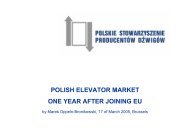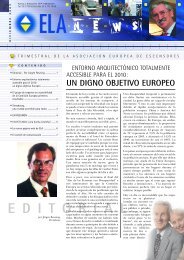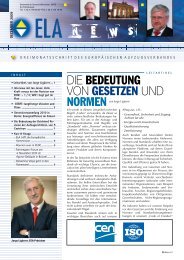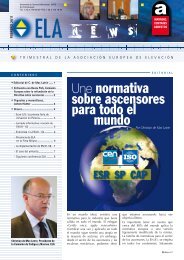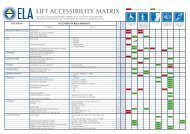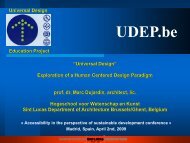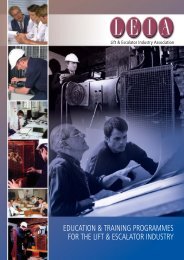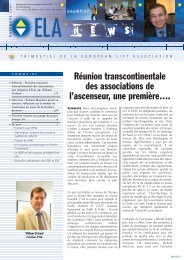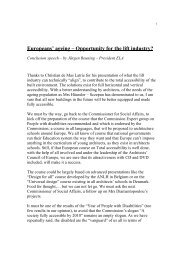WP6-Brochure-E4 brochure - ELA European Lift Association.
WP6-Brochure-E4 brochure - ELA European Lift Association.
WP6-Brochure-E4 brochure - ELA European Lift Association.
Create successful ePaper yourself
Turn your PDF publications into a flip-book with our unique Google optimized e-Paper software.
If the linear motor is mounted on the car itself, then the counterweight can be eliminated, and<br />
the system becomes ropeless. This allows for designs that use horizontal switching between<br />
adjacent hoistways and for multiple cars to travel independently along the same shaft which<br />
leads to almost unlimited control options.<br />
The main limitation to the use of Linear Motors for lift propulsion are the production costs<br />
associated with the large motor length, but they are expected to decrease as the technology<br />
matures.<br />
Linear Motor technology is not expected to reach its full potential in the next few years, but<br />
the technology is clearly worthy of serious consideration for future designs.<br />
This technology has also been used to operate lift doors, reducing moving parts and<br />
maintenance issues significantly. Door problems account for around 40% of all service calls [6].<br />
3.3 Advanced Drives and Regeneration<br />
The choice of the drive has historically been motivated by factors such as travel speed,<br />
levelling accuracy and comfort. Before the introduction of solid‐state control techniques, the<br />
most common option was the Ward Leonard set which provided the best ride quality.<br />
However, there are large energy losses in the motor and generator arrangement, which<br />
converts electrical energy into mechanical energy and finally back to electrical energy again.<br />
The advent of power semiconductors and subsequent evolution of AC motor control<br />
techniques has led to its wide spread use with equivalent ride quality and even some<br />
advantages such as lower maintenance, faster response, energy savings, lower peak demand<br />
and better power factor.<br />
The most common types of motor drives in use today are:<br />
• DC motor with Ward Leonard set<br />
• DC motor with solid state controller<br />
• Two‐speed AC motor<br />
• AC induction motor with Variable Voltage controller<br />
• AC induction motor with Variable Voltage Variable Frequency controller<br />
• AC Permanent Magnet Synchronous Motor with Variable Voltage Variable Frequency<br />
controller<br />
A detailed description of these drive systems can be found in [4].<br />
In DC systems, solid state controllers have been the most common option since the early 90’s,<br />
substituting the Ward Leonard set with great efficiency improvements and more accurate<br />
speed and levelling control. The energy costs when using solid state controllers can be reduced<br />
by as much as 60% when compared with equivalent Ward Leonard drives [4].<br />
21



